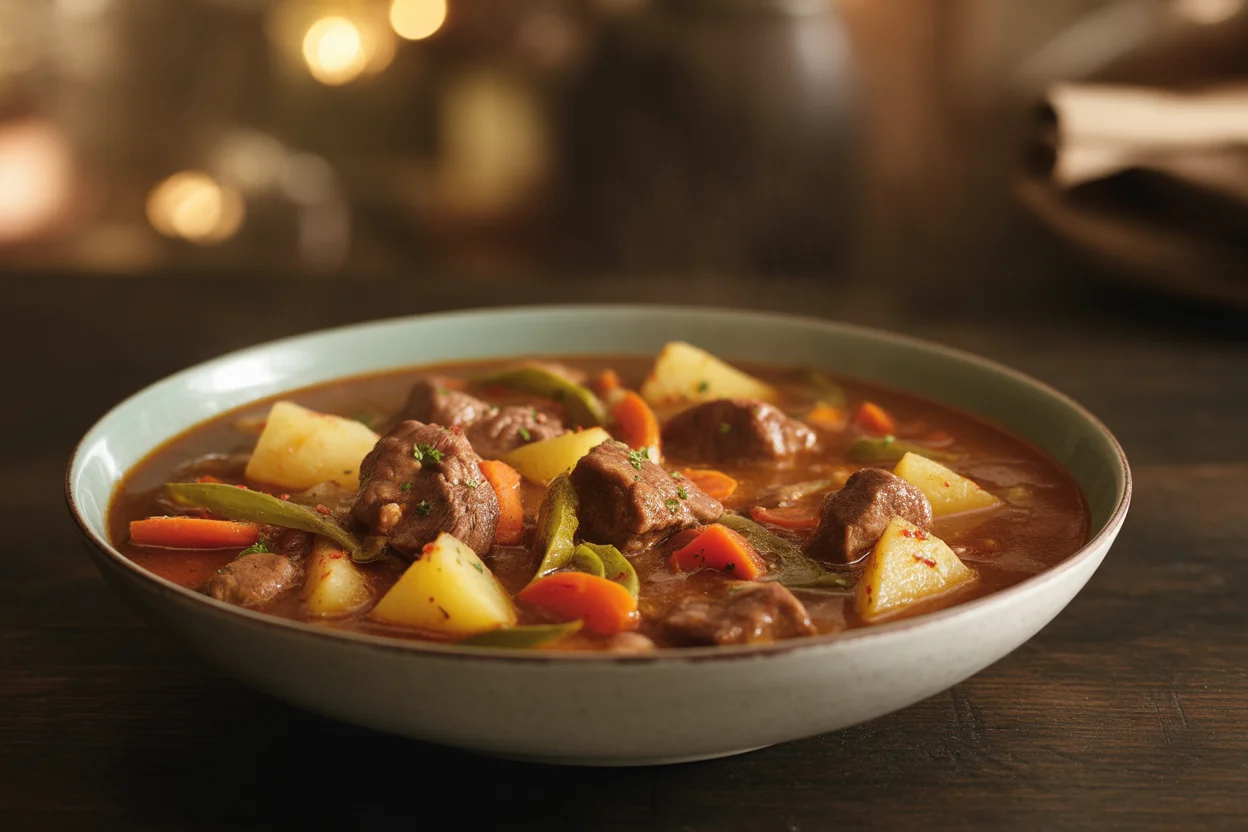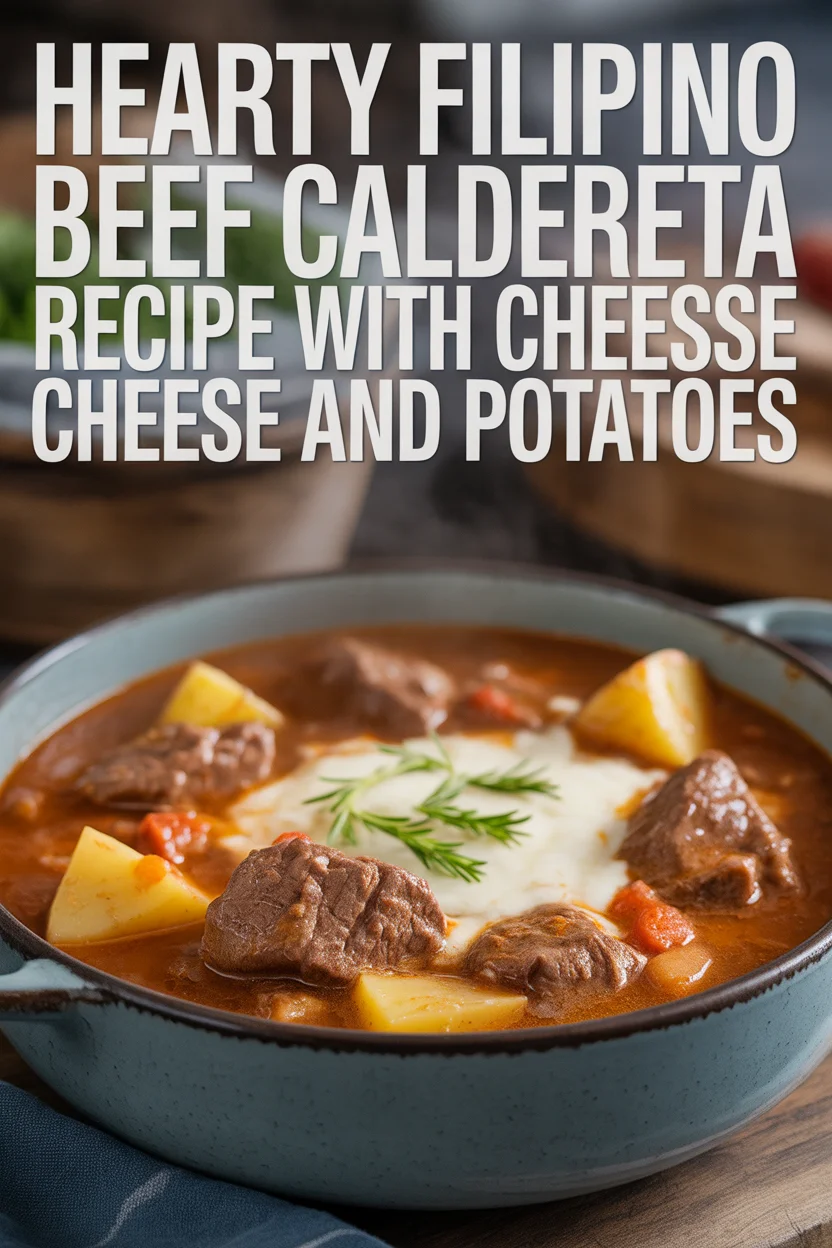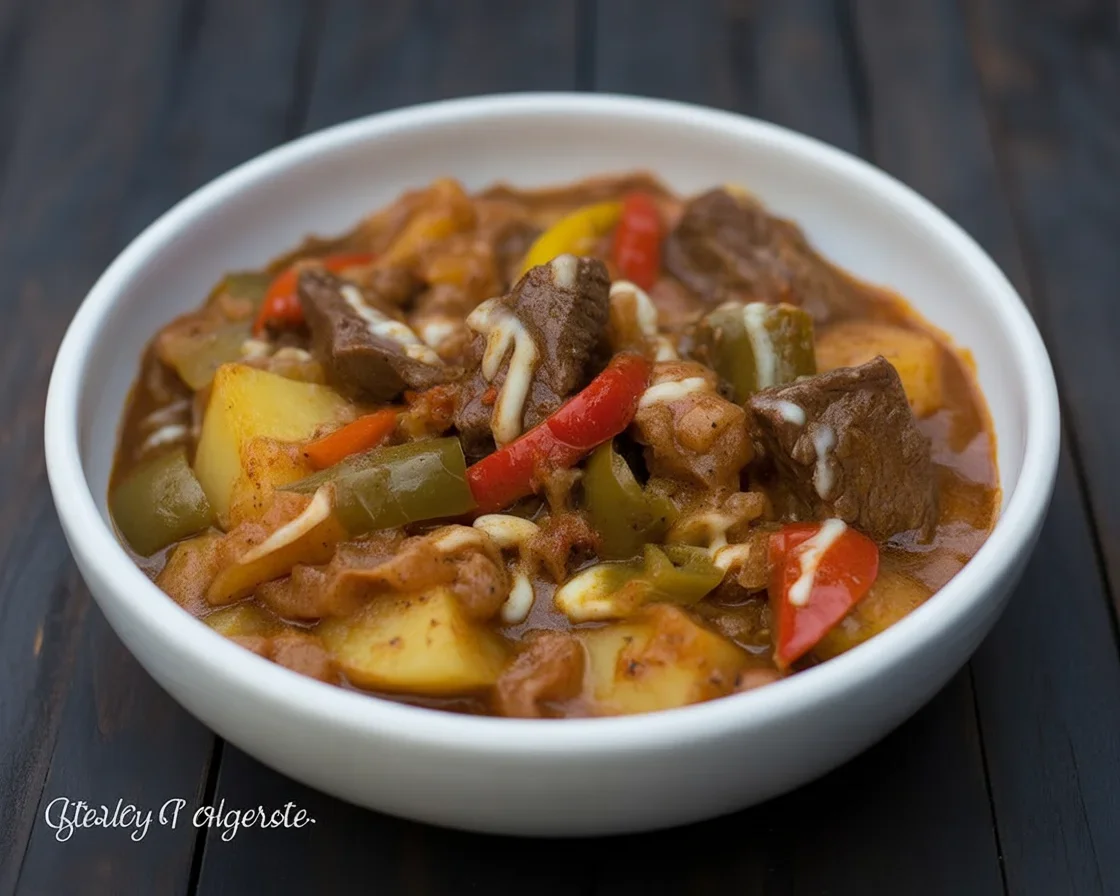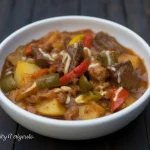Filipino beef caldereta always reminds me of loud family Sundays and, to be honest, last-minute “What’s for dinner?” scrambles. You know those days—hungry people, not many groceries, and some picky eaters in the house? Been there. One pot of this hearty stew, with all that tender beef, potatoes, and cheesy sauce, saves the evening every single time. If you haven’t tried making it yet, let me show you how rewarding it can be. By the way, caldereta is just one of the many stick-to-your-ribs Filipino specialties—kind of like Pinoy Beef Tapa or even a spicy caldereta variation. But this one? Has my heart. 
Introduction to caldereta
Alright, so let’s talk a bit about Filipino beef caldereta. First, it’s a classic Filipino beef stew, totally loaded with flavor. It’s spicy (just a hint, don’t worry), cheesy, super savory, and the beef sorta falls apart on your fork. Everyone in the family has their own spin, too. My mom adds cheese, my tita uses green olives, and my buddy swears you need a splash of pineapple juice (weird, but honestly… not terrible).
This dish is a comfort food through and through. It usually comes out when company’s coming, or when the weather turns rainy and folks crave something piping hot. If you’re trying to impress or you just want a dish that’ll stick to your ribs for hours, you can’t really go wrong here. Also, it goes insanely well with simple rice (or garlic rice if you want an upgrade), and don’t even get me started on leftovers—so good the next day.
Some folks get intimidated, but seriously, you don’t need to be a kitchen wizard to nail this. 
Ingredients
Alright, let’s get down to brass tacks. The magic of Filipino beef caldereta really boils down (pun not intended, but hey) to a handful of main ingredients. Most of these should be easy to nab at any grocery store, or you can swap in what you’ve got. I’m big on making do with the pantry!
You’ll need beef stew chunks—try to find ones with a bit of fat on them, that’s key for flavor. Next up: potatoes, carrots, and bell peppers. Can’t skip the tomato sauce (that’s your main base). Don’t get freaked out, but caldereta calls for liver spread. Stick with me—it boosts the depth of flavor without tasting like, well, liver. There’s cheese (trust me, it’s not optional), plus garlic, onions, a couple of bay leaves, and just a touch of chili for some warmth.
If you’re a sucker for more veggies in your stew, toss in peas or even green olives. And for best results, snag some Filipino-style cheddar if you live near an Asian market. If not, regular cheddar works just fine.
Cooking beef until tender
This is honestly the most important step, in my opinion. If you rush it, you get chewy, grumpy beef—nobody wants that, right? It’s simple: I sauté the beef first, just til it gets a bit of browning. I usually sizzle it in a splash of oil with some onions and garlic for that starting base flavor.
Once things are starting to smell good, you add water (not too much, just enough to barely cover the meat) and let it simmer like your life depends on it. I’m talking at least 45 minutes, sometimes up to 2 hours if I have time and patience (most days, not so much, but we try). Skim off any scum on top if you see it—nothing fancy, just grab a spoon and do your best.
Your goal? Beef that your spoon can almost cut through. If it’s tough, just keep going—seriously, patience is the secret here. That’s pretty much it for this step.
Adding tomato sauce and liver spread
Now’s when things get real. After your beef is basically ready to melt, pour in that tomato sauce. Don’t use fresh tomatoes unless you’re feeling fancy and have an extra hour, which I never do. The sauce should color the pot a beautiful red.
After a stir, scoop in your liver spread. This is where people get a bit nervous, but trust me—it blends in for velvety sauce, and the aftertaste is just richness, not weird at all. If you’re skittish, start with half a can, taste, and go from there. You might even be surprised how “restaurant-level” your sauce gets.
Let all that burble together for a few minutes. This is when your kitchen really starts to smell like a Filipino family party—seriously, if nobody asks what’s cooking, it’s not caldereta!
Mixing in vegetables and cheese
Here’s the fun part. Chop your potatoes and carrots kind of chunky, so they don’t fall apart while cooking. Add them in, let them simmer until they’re fork-tender. If you like bell peppers, throw them in near the end so they keep a tiny bit of crunch.
Last but not least: Cheese. Grate as much as you want (and then a little more). Sprinkle it straight into the pot and let it melt in with a quick stir. The first time I tried cheese in caldereta, I thought it was extra, but wow, it makes the stew creamy and just a little decadent.
If you’re a flavor chaser, olives and peas can jump in now too. You decide your adventure here!
“The first time I made Filipino beef caldereta, I had three bowls. My family thought restaurant food had landed in our kitchen. So cheesy, so hearty. I’m never making stew without cheese again.” – Liza R., real home cook
Simmering and serving tips
Ready to serve? Not quite yet. Let your pot simmer for about ten extra minutes, uncovered, so the sauce thickens up and veggies finish getting soft. Give it a little taste and add salt and pepper as needed—sometimes a splash of fish sauce, if you’re feeling brave.
Time to dish up! Here’s some serving ideas:
- Pile it high on white rice (or make it even better with some garlic sinangag).
- Serve it family-style in a big pot, so everyone can help themselves.
- Try it with crusty bread—sounds odd but soaks up all that sauce.
- And hey, throw in a green salad for balance if you want to feel fancy.
Caldereta practically begs for second helpings, so don’t be shy.
Storage and reheating tips
Here’s a truth: Filipino beef caldereta almost gets tastier the second day. Leftovers? Just pop them in an airtight container, stick them in the fridge, and they’ll be good for about 3 or 4 days.
Reheating is easy—just use the microwave in short bursts, or warm it gently on the stove. If the sauce looks thick, splash in a little water to loosen it up. Don’t forget to give it a good stir. And—no judgment—sometimes I eat a cold spoonful right out of the fridge (not recommended for the faint of heart).
Leftover caldereta also freezes well for about a month. Thaw it overnight in the fridge before heating, and you’re golden.
Common Questions
Do I really need to use liver spread?
Honestly, yeah, it brings that extra richness. If you’re not about it, you could skip it—or try a mashed-up chicken liver, which is old-school!
Can I use another meat besides beef?
Sure thing! Chicken works, or some folks use pork. Just adjust the cooking time, since chicken’s a lot faster to tenderize.
What’s the best beef cut for caldereta?
I stick with beef chuck or brisket—super forgiving and flavorful. Avoid anything too lean, it tends to dry out.
How do I make it less spicy?
Simply skip or use less chili. If you want heat, you can always add some hot sauce at the table.
Can kids eat Filipino beef caldereta?
You bet—just go easy on the spice, and it’ll be a family hit. For more ideas, peek at these kid-friendly Filipino recipes.

Want even more Filipino beef caldereta inspiration? Peek at these tried-and-true classics: the Beef Kaldereta Recipe – Panlasang Pinoy has nice tips for different beef cuts, and Filipino Beef Caldereta – GypsyPlate offers excellent side dish ideas. Promise—after your first bite, you’ll be bringing this dish out again and again. Give it a go and let your kitchen smell like home!
Filipino Beef Caldereta
Ingredients
Main Ingredients
- 2 lbs beef stew chunks Choose cuts with some fat for better flavor.
- 2 medium potatoes Chopped into chunks.
- 2 medium carrots Chopped into chunks.
- 1 medium bell pepper Chopped, added towards the end of cooking.
- 1 can tomato sauce Main base of the stew.
- 1 can liver spread Adds depth of flavor.
- 1 cup cheese Filipino-style cheddar or regular cheddar, grated.
- 4 cloves garlic Minced.
- 1 medium onion Chopped.
- 2 pieces bay leaves For flavor.
- 1 teaspoon chili Cayenne or similar, adjust to taste.
Optional Ingredients
- 1 cup peas For added veggies.
- 1/2 cup green olives Optional for flavor.
Instructions
Cooking the Beef
- Sauté the beef chunks in a splash of oil with onions and garlic until browned.
- Add water just enough to cover the meat and simmer for 45 minutes to 2 hours until tender.
- Skim off any scum that rises to the surface during simmering.
Adding Sauce
- Once the beef is tender, pour in the tomato sauce and stir.
- Add the liver spread, starting with half a can, and mix well.
- Let simmer for a few minutes until well blended.
Mixing Vegetables and Cheese
- Add the potatoes and carrots to the pot and simmer until fork-tender.
- If using, add bell peppers near the end of cooking.
- Grate and stir in the cheese until melted.
- Optionally, add peas or olives for extra flavor.
Final Simmer
- Simmer uncovered for about 10 minutes to thicken the sauce.
- Taste and adjust seasoning with salt, pepper, or fish sauce if desired.
Serving Suggestions
- Serve over white rice or garlic rice.
- Present in a large pot for family-style serving.
- Pair with crusty bread and a side salad.


2 thoughts on “Hearty Filipino Beef Caldereta Recipe with Cheese and Potatoes”